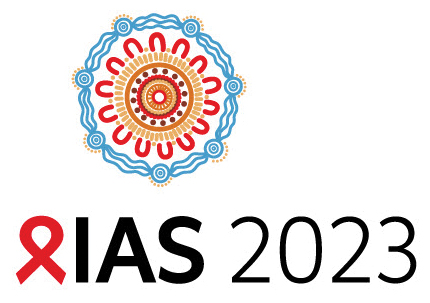As he introduced a session at IAS 2023, Elwin Wu, co-director of the Social Intervention Group and the HIV Intervention Science Training Program for Underrepresented New Investigators at Columbia University, urged colleagues to “elevate voices without imposing a white Eurocentric POV [point-of-view],” and to “decolonize scientific methods,” when developing interventions for vulnerable populations.

Populations include adolescents, racial/ethnic minorities, immigrants, people impacted by the justice system, people who use substances, and sexual and gender minorities. Several presenters showed how tech-based interventions could help vulnerable populations prevent HIV and other sexually transmitted acquisitions. What can bridge the gaps with those populations, provided people have access to it, is technology, and presenters shared different ways tech can meet people where they’re at to provide sexual health information.
Chatbots for survivors of gender-based violence
Peter Memiah, DrPH, MSc, program director of Implementation and Dissemination Science at the University of Maryland, described how a chatbot could help leverage technology to give people access to information on gender-based violence (GBV). It is estimated that one out of three women, one out of four men, and 1 in 10 youth will experience GBV in their lifetimes and they, Memiah noted, are vulnerable to both HIV and unwanted pregnancy.
“Most don’t get any help for GBV and they need to get connected to services quickly,” he said. His proposal, AGILE—Accelerating Access to GBV Information and Services Leveraging a Technology Enhanced
Chatbot—is an artificial intelligence (AI)-powered chatbot that can quiz users on the risks that they may be experiencing, and immediately offer service recommendations. The AGILE pilot is aimed at youth in Kenya. He explained a possible scenario: “A young woman, call her Lisa, who is beaten by her boyfriend, can use this app to get immediate help, whether she needs health services or police.”
There is enthusiasm for tech in Kenya, he said, “but we just scratched the surface.” Memiah said the AGILE platform should be available to the public before the end of the year.
Relationship and dating role-play through an interactive app
Interactive technology can also improve HIV education, said Caroline Kingori, associate dean for Research and Faculty Affairs at Ohio University, who shared early results of Dating Forward, a dating simulation app intended to help immigrant and refugee youth, a vulnerable population for HIV. Dating Forward is a collaboration between Ohio’s GRID Lab and Ethiopian Tewahedo Social Services (ETSS), an Ohio organization that supports immigrant and refugee youth with a goal of helping them make more informed decisions about sexual health. “We want the app to increase knowledge and decrease unsafe behavior and reduce stigma,” Kingori said.
Kingori and colleagues focused on Somali youth 18–25 years old. To test youths’ knowledge of HIV, they built an interactive app in which users can see how a couple—for the first iteration it’s a male-female couple—navigates dating. Users of this app can help the characters make various choices—to get tested for HIV and STIs or not, for example—and change the characters’ outcomes. Kingori’s team is utilizing user feedback to refine the app. “Users said they were impressed with the testing scene and that they learned something new, but they were still not comfortable discussing HIV in person,” Kingori said. Dating Forward can be found at New American Youth Health Resource (nayhr.org).
Using social media for culturally-tailored sexual health promotion
In presenting a pilot social media app, to “meet users where they are,” with their understanding of sexual health, Jaih Craddock, assistant professor at the University of California-Irvine School of Medicine, set the stage with statistics for young Black men.
“HIV rates for young Black men ages 25–34 are stable, even though rates of HIV for other groups are going down,” Craddock said.
Craddock and colleagues surveyed 19 young adults 18–24 years old in Baltimore to learn what they wanted from a tech-based social media app to provide sexual health information.
“They told us they want: culturally tailored sexual health interventions,” Craddock said. Specifically, respondents said they related to “people like us” better, “someone who looks like us and talks like us.” Respondents also wanted in-depth information on a range of sexual health and relationship topics—including hygiene and mental health—in addition to HIV. They also wanted guidance on tough conversations on sex. “Even one straight man wanted general information about same sex relationships,” he added.
Will they use such an app? “Yes, if you make it easy to use, make it engaging and entertaining and constantly update it with new information,” Craddock said. “Don’t assume because they have social media literacy that they have digital health literacy.” Also, make the intended users of the app part of building and implementing it. “Keep them involved,” he said. “For example, one respondent asked us if he could host a podcast episode on a topic.”
Telemed for sexual and reproductive health services
Telemedicine was on the rise before the COVID-19 pandemic put health care in a tailspin, but the convenience of it, for people who could access it, really took off at the start of the pandemic, and continues to be popular.
Megan Threats, an assistant professor at the University of Michigan School of Information and a health informaticist, shared results of a study to understand how well women would accept telemed apps and chatbots to access sexual and reproductive health services, including HPV vaccination, cervical cancer screening and HIV testing.
In a nationwide survey based in the U.S., Threats and colleagues recruited both cis and trans women from a variety of races—Black, Native American, Asian and Pacific Islander among others—from ads on social media and aps for queer women and community services. Out of a total of 135 participants with an average age of 25, 65 were Black and 55 percent identified as bisexual.
Three out of four said they favored video calls and an even greater number, 82 percent, said video calls were more convenient than in-person visits. Chatbots regarding HPV risk were favored by 72 percent.
“Our survey also showed they have low knowledge of HIV and STIs, as well as cancer risks,” Threats said. “More than 60 percent had past discrimination that deter them from using in-person healthcare. We also found that the higher the education level, the more likely they were to use chatbots.”


